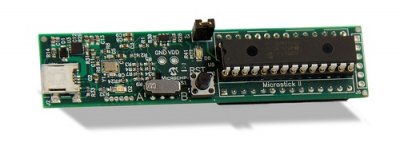- Home»
- News»
- All News Articles»
- New Development Platforms
20 Feb 2012
The Microstick II tool from Microchip is possibly the cheapest starter kit available for developing and evaluating 16-bit and 32-bit PIC MCUs, and 16-bit DSCs.
This flexible tool provides all the basic features needed to get started with these MCUs and DSCs, and includes a USB interface, an integrated programmer and debugger, a user LED, a reset button, and a DUT socket for switching devices. Since the device is USB powered, no battery or external power source would be required.

These features are all contained in a very small package that is about the size of a stick of gum (about 20 x76mm), and makes it extremely easy to start developing with MCUs and DSCs. In addition, two 1x14 header pins (0.025”) are included in the kit for using with a prototype board, so designers can easily plug the Microstick II tool into a standard prototyping board for experimenting with external circuitry, and also provides space for jumper wires.
There are 19 flexible I/O pins available that should have enough interface capability for their new application ideas.
There is easy access to all I/O features included on the device. One great feature is that many of the I/O pins are configurable with Microchip’s Peripheral Pin Select (PPS) so the internal hardware can be mapped to any of the pins at any time. For example, it is possible to connect an I2C port which uses the same set of pins that are used for an ADC input.
The Microstick II includes two types of PIC24 chips, a PIC32 chip, and a dsPIC33 digital signal processing chip. The kit will support any of the dsPIC33s in a SPDIP package, and any of Microchip’s 16- or 32-bit MCUs with a 28-pin SPDIP package that would match the power and debugger/programmer interface pins shown on the enclosed schematic. This is somewhat limited compared to a PICKit3, but is much cheaper.
Free demo code is provided, along with installation instructions and board schematic. Most of the code samples are written in the C programming language and requires a C compiler to be installed. A free C compiler is available, along with the free MPLAB Integrated Development Environment (IDE) software. The kit is designed to be used with MPLAB IDE, and this tool provides assembler tools for development, so the C compiler wouldn’t be needed if only assembly language is used to program the code.
A designer can buy several types of MCUs and DSCs in addition to what is supplied in the kit which can plug into the Microstick II, and each one can be tried out in his design to find the best possible solution. Some designers prefer to use UART as a programming port instead of USB, and it would be possible to use UART in the Microstick II, but external level shifter circuitry would have to be added to this to connect it to the PC or other programming source.
